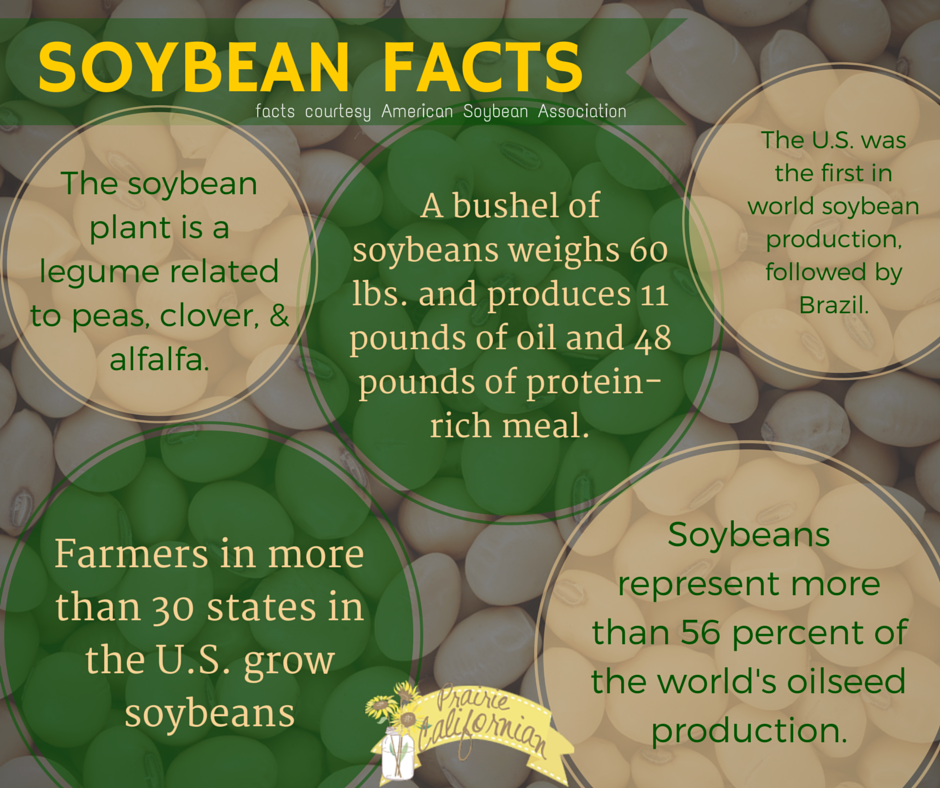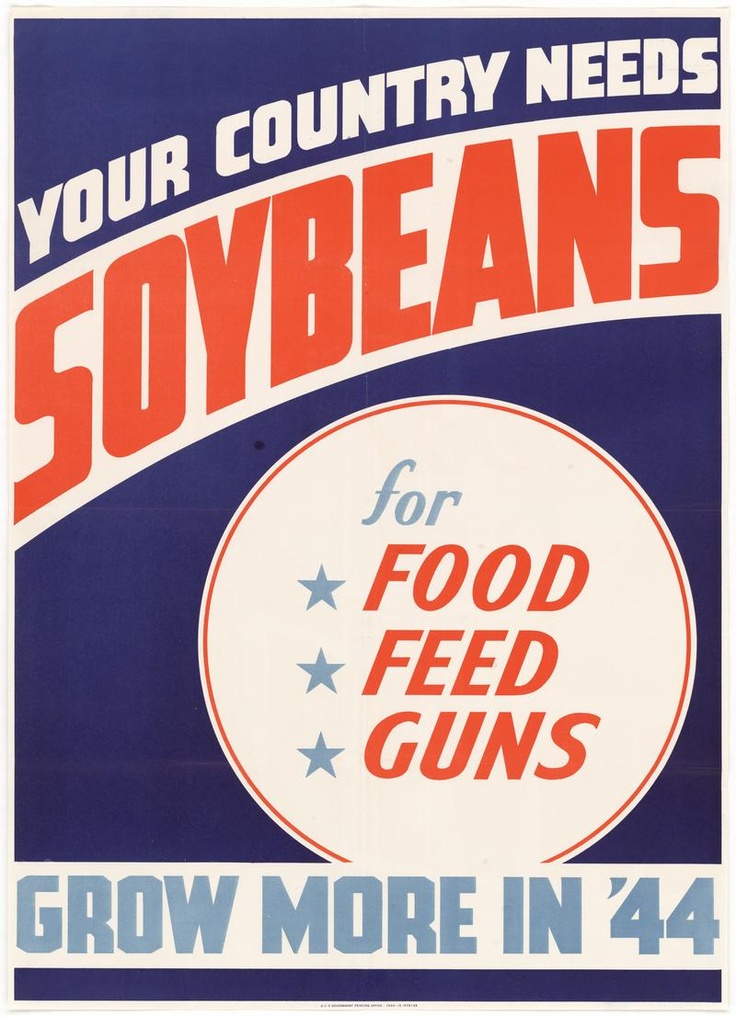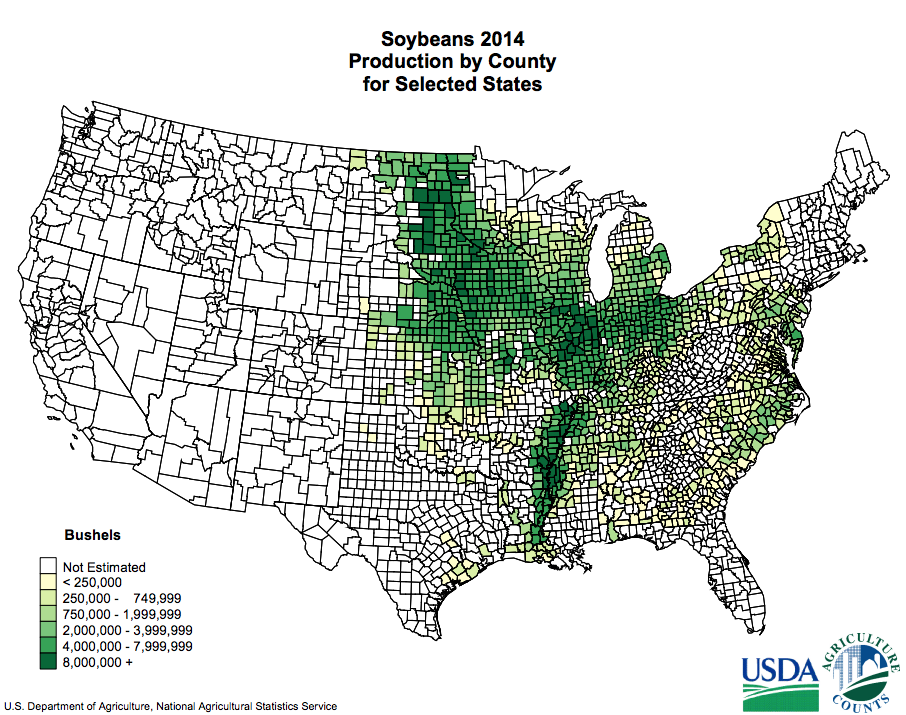
Soybeans. What comes to mind when you think of soybeans? For me it is typically tofu.
Today, soybeans are the United States’ second largest crop in cash sales and the number one export crop, with about 40 percent of the world’s soybean trade originating from the U.S. Here in North Dakota, soybeans production has taken off making North Dakota a major player in the U.S. soybean production. In the last 20 years in North Dakota, soybean production has increased by 627%!
We grow soybeans on our farm because they are a great stable crop for our area. Soybeans allow us to maintain good weed control as well as are a pretty tolerant crop. We need a crop that can be seeded into wheat residue that has the potential to be wet and soybeans allow us to seed in a wide range of planting dates.
To kick off soybeans during Crop of the Month, I wanted to sort of cover an introduction of where soybeans came from, why they are grown here in the United States, and what are they used for?
Why did we start growing soybeans? Where did they come from?
The first domestication of soybeans has been traced back to North China around 11th century BC. Soybean has been one of the five main plant foods of China along with rice, wheat, barley, and millet. Soybeans hit the American colonies around 1765 and early authors made mention that soybeans tended to be well adapted to Pennsylvania soil. At that time, many of the early U.S. soybeans were used as a forage crop rather than harvested for seed.
In 1904, famous American chemist George Washington Carver discovered that soybeans are a valuable source of protein and oil. His discoveries forever changed the way people thought of soybeans, no longer were it grown as a forage crop and research of soybeans began here on American soil. In 1919, the American Soybean Association was founded and in 1929, co-founder and president William Morse spent two years gathering soybeans in China. Morse understood that new, improved varieties meant better production for farmers. He brought back more than 10,000 varieties for study and research.
It wasn’t until the 1940’s that soybean farming across the nation really took off in America. Prior to World War II, the United States imported nearly 40 percent of its edible fats and oil. At the start of the war, soybean production in China was halted. And later when the U.S. entered the war, the increase for oils, lubricants, plastics, and other products exponentially increased the demand for soybeans. Soybeans more than doubled during the war and increased an amazing 77% from 1941-1942. The soybean became referred to as “the miracle bean” or “the Cinderella bean” and was commonly featured amongst many war time posters encouraging farmers to increase soybean acres.
During the 1950’s, coupled with post-war prosperity and improved diets, demand for meat consumption increased. Livestock producers found that soybean meal was a great source of protein at an affordable cost. Chickens, turkeys, and hogs were fed diets containing soybean meal which ended up in a huge expansion of the U.S. agriculture industry. It was also during this time that the United States looked to expand export markets. In 1956, American Soybean Association opened its first international office in Japan. Today, ASA promotes U.S. soybean and soy product exports in more than 80 countries across the globe.
Where are soybeans grown?
Today, the geography of has changed. Production in Southern U.S. has declined, but this decline has been made up by expansion northward and westward as new seed varieties requiring less growing time and tolerant of drier conditions were developed. Today, Illinois and Iowa are the largest producing states. Northern states such as Minnesota, Nebraska, South Dakota and North Dakota were once considered too far north for soybean production are now amongst the top 10 producing states. Farmers in more than 30 states grow soybeans. Check out the production map below.
So what are soybeans used for today?
The majority of soybean crops are processed into oil and meal. A 60 pound bushel of soybeans yields about 11 pounds of oil and 48 pounds of meal.
Oil is extracted from the soybeans and made into shortening, margarine, cooking oil (vegetable oil), and salad dressings. Extractions from soy oil are also used in many food, commercial, and industrial applications. For example, lecithin, an emulsifier can help keep chocolate and cocoa butter in a candy bar from separating. It is also used in pharmaceuticals and protective coatings as well.
One of my favorite uses for soybeans is crayons! Did you know that 1 acre of soybeans can produce nearly 82,368 crayons?
Soy oil is also used in industrial paint, varnishes, caulking, linoleum, and inks. Development efforts in recent years have also resulted in several soy-based lubricant and fuel products like biodiesels that replace non-renewable petroleum products.
After extracting the oil, what is left is a high protein meal, which can be fed to animals. Soybean protein in animal feed helps balance nutrient deficiencies of grains such as corn or wheat, which tend to be low in amino acids.
The use of soybeans and other vegetable proteins for human consumption in the United States continues to expand. Soybeans can be used for many meat and dairy substitutes or even gluten-free alternatives. Soyfoods are cholesterol free, an excellent source of high quality protein, and offer a healthy mix of polyunsaturated fat. There is evidence supporting soyfoods playing a role in reducing the risk of several chronic diseases.
Conclusion
The market for soybeans and its’ many products continues to be global. China has become the largest single country consumer for U.S. soybeans along with other countries like Mexico, European Union, and Japan. The U.S. market for soybeans is well established with quality standards specified by either government or industry adopted trading rules to ensure buyers know they are getting the quality for which they paid and contracted.
The continual industry-wide drive for improvements in soybeans from farm to fork is keeping U.S. soybeans and soy products at the forefront of global markets as well as at here in the United States.
Resources
Gibson, L. & Benson, G. (2005). Origin, History, & Uses of Soybeans.
Karlin, J (2014). What is Fueling the ND Corn/Soybean Surge?
North Carolina Soybean Producers Association (2015). Uses of Soybeans. & History of Soybeans
Swenson, A. (2005). Soybeans in North Dakota – Will the Trend Continue?
USSEC. (2012). Chapter One: The Soybean, It’s History, and It’s Opportunities.
Wisconsin Soybean Association. (2015). U.S. Soybean Facts.






2 Comments